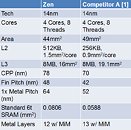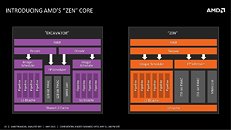Raevenlord
News Editor
- Joined
- Aug 12, 2016
- Messages
- 3,755 (1.21/day)
- Location
- Portugal
| System Name | The Ryzening |
|---|---|
| Processor | AMD Ryzen 9 5900X |
| Motherboard | MSI X570 MAG TOMAHAWK |
| Cooling | Lian Li Galahad 360mm AIO |
| Memory | 32 GB G.Skill Trident Z F4-3733 (4x 8 GB) |
| Video Card(s) | Gigabyte RTX 3070 Ti |
| Storage | Boot: Transcend MTE220S 2TB, Kintson A2000 1TB, Seagate Firewolf Pro 14 TB |
| Display(s) | Acer Nitro VG270UP (1440p 144 Hz IPS) |
| Case | Lian Li O11DX Dynamic White |
| Audio Device(s) | iFi Audio Zen DAC |
| Power Supply | Seasonic Focus+ 750 W |
| Mouse | Cooler Master Masterkeys Lite L |
| Keyboard | Cooler Master Masterkeys Lite L |
| Software | Windows 10 x64 |
At the International Solid State Circuits Conference (ISSCC), AMD presented a whitepaper in which they demonstrated how its upcoming Zen x86 core fits into a 10 percent smaller die area than Intel's currently shipping second-generation 14nm processor. According to reports, analysts and Intel engineers in the session said the Zen core is clearly competitive, though many as-of-yet unknown variables will determine whether the die advantage translates into lower costs for AMD. That said, one thing is clear: the chip will have to perform in addition to being smaller, if AMD wants to ever capitalize on the potentially higher margins a smaller die could grant them.
One of the ways AMD improved upon its ZEN core in comparison to its previous products has been on switching capacitance for their new chips, with a reported overall 15% improvement. In addition, AMD has apparently moved on to a metal-insulator-metal capacitor design, thus achieving lower operating voltages as well as as more fine-grained per-core voltage and frequency control (on to become part of their SenseMI technology suite). Looking at the image, which pits an AMD ZEN chip to a comparable Intel solution, we see that AMD saves additional die space by making do with only 12 metal layers as well as overall lower L2 and L3 cache footprints.



View at TechPowerUp Main Site
One of the ways AMD improved upon its ZEN core in comparison to its previous products has been on switching capacitance for their new chips, with a reported overall 15% improvement. In addition, AMD has apparently moved on to a metal-insulator-metal capacitor design, thus achieving lower operating voltages as well as as more fine-grained per-core voltage and frequency control (on to become part of their SenseMI technology suite). Looking at the image, which pits an AMD ZEN chip to a comparable Intel solution, we see that AMD saves additional die space by making do with only 12 metal layers as well as overall lower L2 and L3 cache footprints.



View at TechPowerUp Main Site
Last edited:










